Join Redemption Elder Chris Fachman for part 2 of a series spoiling details about the upcoming Israel’s Deliverance starter decks!
We are picking up where Tyler left off in part 1, so if you haven’t read that, please go back and do so that way everyone is on the same page. We are going to talk a little bit more about simplicity before getting into another topic. As Tyler mentioned we are trying to simplify abilities and make the game easier for new or existing players from other card games to transition into. So one of the things that means we need to do is make the game more intuitive as well as a bit less confusing. Tyler mentioned the community playtesting for us at the 2022 National tournament and one thing we found was that all the negating interactions could be very time consuming and confusing to keep up with. While we have no intention of getting rid of negate, the starters at Nationals had a few cards that not only negated, but then became a battle winner as well, so there were long interactions of trying to figure out what cards were still active, or reactivating. What cards were being removed from battle, but this negate brought this one back. You get the point. So to simplify the game and make entry easier, a handful of cards got toned down to make these interactions less of a headache, and not need a calculator. The biggest culprit was the evil spears. So this is what they look like now!
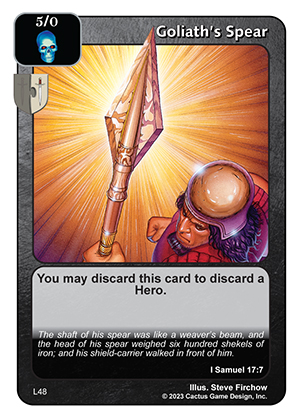
Going further into the new player experience, the team has really devoted our time and efforts into making sure that when someone sits down at the table to play this game that they feel like they at least get to play. Anyone who has played in the last two years has seen decks that our community has said felt like them playing Solitaire while they just watched themselves lose with nothing to do about it. One of the biggest culprits of allowing this type of play are cards that people use to make their decks more consistent. Basically, this is using cards to go get the handful of cards they need in that moment to make sure their opponents have no response. Since this is something we do not want our players, especially new ones, to deal with, here are a couple of examples of cards changing because they allowed players to be too consistent.
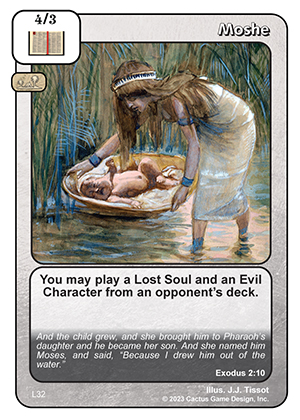
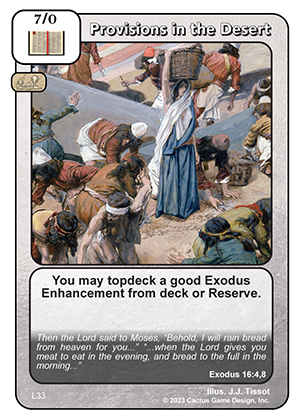
Provisions is a very simple explanation. Being able to take an enhancement to make sure you do exactly what you need to do in the moment is a very strong way to “set up” before the opponent does. By topdecking the card you now have to have a way to still get to that card, mostly through draw in battle as you used your one territory class card, for your deck to become more consistent. The change to Moshe was a little bittersweet, as Tyler and I felt like the ability for it was extremely unique and created a lot of choices to be played from you or your opponent’s deck, but we were noticing that it allowed people to grab that certain hero they wanted to attack with and that Lost Soul to gain an extra benefit, so we have changed it to be closer to what it was initially based off of. Originally, it was based off the TeP version of The Woman at the Well, which allowed you to generate a soul to rescue but also not leave your opponent without a character to block with. Anyone who has played for any amount of time can say one very frustrating thing is to give an opponent a free Lost Soul because you have no blocker, so this change mitigates this and allows the game to flow the way it was meant to with a battle between good and evil.
Changing gears now, I wanted to take a little time to talk about brigades. If you have played Redemption at all you know that different themes have a brigade that they fit in. There are also cards, in particular Heroes, that can fit within many different themes and therefore have multiple brigades. While that is something we are going to continue to do, multiple brigade cards are going to start seeing a smaller total within sets than they have in the past. With trying to simplify the game, allowing a new player to find a theme or brigade they like and focus on just collecting that brigade is something we want to encourage. Don’t fret veterans, there will still be opportunities to splash brigades together, but that is not something we always want to encourage. With us focusing more on the single brigade cards, that means we get a lot of flexibility with some cards that can fit in multiple themes. One good example of this is Abiathar. While he is a priest and therefore could be Clay, we wanted to represent his ties to David within the starter decks.
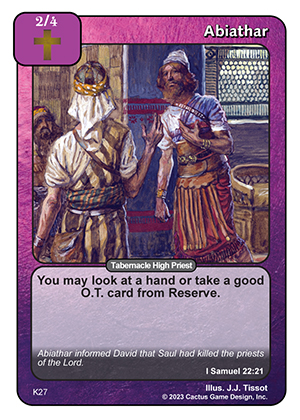
This allows us in the future to also create a “Clay priest” version of this card if and/or when we get back to this portion of the Bible, or need to flesh out that theme. The fun thing about this philosophy when it comes to brigades is we get to potentially flesh out some themes with some cards that do not necessarily fit within the strict definition of brigade themes. One example of this is the Hero Hannah. Green has generally been reserved for Prophets, and prophets only. We know that Hannah was not a prophet, but her whole story is surrounded by them. She prayed for a son, and promised to dedicate him to the Lord. Her son was Samuel, a prophet, and she took him to work alongside another prophet, Eli. So while Hannah doesn’t have a “proper” brigade to go to, she certainly feels like someone who should be in the Green brigade even if she wasn’t a prophet herself.

This leads me to the main characters of the starters. When we were creating the starters, the team took the time to really discuss and ask people what should be included. The previous starters had characters and stories from both the Old Testament and the New Testament. The I/J starters even had angels and demons which tend to be young players’ favorites. So many things were considered, but when it came time to make the decision it was clear. The two stories that people with little knowledge of the Bible typically knew were the stories of David versus Goliath and Moses standing up to Pharaoh. We already knew, as Tyler mentioned, that we wanted to have two good brigades in the starters, but we were worried about how well they played together because past starters felt like two different decks within the same deck. So we wanted this experience to be more “cohesive.” That ultimately became rather easy because David was a mighty king and led a large group of people, but also had prophets anoint and stand beside him. The same can be said about the Israelites during the Exodus. Since the first priests were ordained while they were in the wilderness the brigades became clear, which was Purple (for royalty & David’s companions) & Green (for the prophets). Then for Exodus we had White (the brigade for Exodus Heroes) and Teal (the brigade for priests). Whoops, sorry, I meant Clay! More on that in just a moment. The only other issue we had was that we wanted Moses to be the main focus of his offense, but yet he wasn’t a priest. So how do we make this work? Well, that is why I told the previous story of Abiathar and Hannah. While Moses was not a priest, he is of the same lineage as Aaron and the first priests. But he also performed the tasks to consecrate the first priests. So in a way, he performed priestly duties to set apart the called priests. This allows us to “get away” with giving him the Clay brigade, but yet not being a priest, much like Hannah in Green.

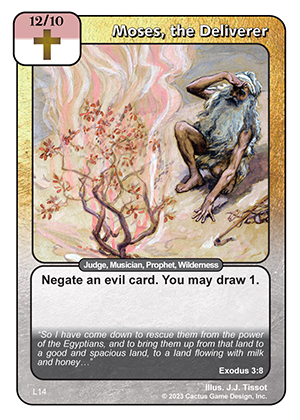
This brings this extremely long article, sorry I can’t figure out how to shut up, to the last section. As I slipped up when talking about the Teal brigade, we need to discuss brigades for a moment. Another thing the team thought long and hard about as we were planning these new starters was the amount of brigades that we had and considering cutting some. There are multiple reasons we discussed for doing so or not doing so, and then conversations of how many to cut and what our end goal was. Ultimately two of the main factors in deciding to cut some brigades is again the player experience and size of sets moving forward. When a new player comes in, the fact that we have 16 different brigades, each with multiple themes in them, creates a large burden for people to decide how to focus their time and their money. Cutting brigades allows people to have more options within those brigades and overall less choices for the brigade. Another part of this was the request from Rob Anderson for us to drop back to 129 card sets for the foreseeable future. As much as the huge sets of Lineage of Christ and Gospel of Christ were fun, all encompassing, and exciting for collectors, it was daunting for some including Rob. So with the smaller set size trying to hit every brigade every few years was nearly impossible. So cutting a few brigades allows us to make sure every brigade gets love more frequently and not just a card or two here or there.
As many of you have noticed from the starters already, you see that Teal and Evil Gold have been cut. Teal was a fairly easy choice because it has the lowest card count with Rotation, and the game in general. We also now have the ability to flesh out both an Old and New Testament theme within the Clay brigade. We also feel it fits well because in First Peter, Peter calls his fellow believers a “royal priesthood.” With Jesus tearing the veil between us and God, we can now communicate directly to God Himself, like the priests did for the Israelites before Jesus. Removing Evil Gold is more for game play purposes than potential Biblical ones. Having two brigades named Gold is just unnecessarily confusing. We have to specify on cards if we want them to do something with good, evil or either. So while this one had nothing to do with lack of card pool, or a cool story, it was all about simplicity. What some of you have not quite figured out yet, is that we aren’t quite done yet. There have been a handful of people who have figured it out, but not everyone. There is one more brigade that has been cut. To give you an opportunity to guess, the main reason this brigade got cut is because it has ultimately lost its identity. Also, cutting one more brigade gives us fun thematic numbers! Seven good brigades and six evil brigades, both numbers representing good and evil within the Bible! So what lost its identity? Well, outside of Lineage of Christ which gave this brigade a very unique way to depict the bloodline of Jesus Himself, Red has lost its way. Red had become that brigade that simply said “Oh, this guy fought in a battle? Let’s just slap Red and Warrior class on him and be done.” By removing the Red brigade we can now move different characters to a more appropriate theme other than just “he is a warrior.” This allows us to have fun with different groups of people and potentially move some to different brigades than we could have before. We are sorry to all of those who are losing a brigade that they have loved for a long period of time. But, with the goal of streamlining this game for everyone involved, these are some of the tough decisions the leadership team has made for what we hope is better for the game as a whole! Don’t be too sad, more spoilers are just around the corner!
To buy singles, sealed product, and other gaming supplies mentioned, please visit our sponsors!
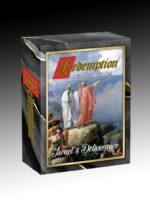
Josiah Beers
Seems like good choices for the health of the game. I hope these trends stay in place. 129 card sets seem way healthier for the game, collectors, new players, and the volunteer play testers.
Chad
Thanks for the feedback Josiah. And agreed the direction described in this article does feel good for the health of the game.